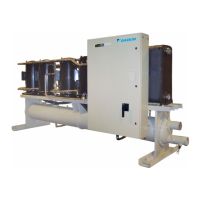IM 1131-2 7
Water Piping
Figure 3: Typical Evaporator Field Water Piping (WGZ150 - WGZ200)
System Water Volume
It is important to have adequate water volume in the system to
provide an opportunity for the chiller to sense a load change,
adjust to the change, and then stabilize. The system water
volume is the total amount of water in the evaporator, air
handling equipment, and associated piping. As the expected
load change becomes more rapid, a greater water volume is
needed. If the water volume is too low, operational problems
can occur including rapid compressor cycling, rapid loading
and unloading of compressors, erratic refrigerant flow in the
chiller, improper motor cooling, shortened equipment life and
other undesirable occurrences.
For normal comfort cooling applications where the cooling
load changes relatively slowly, a minimum system volume of
two to three minutes times the flow rate (GPM) is
recommended. For example, if the design chiller flow rate is
120 gpm, we recommend a system volume of 240 to 360
gallons.
For process applications where the cooling load can change
rapidly, additional system water volume is needed. A process
example would be the quenching of hot metal objects. The
load would be very stable until the hot metal is dipped into the
water tank. Then, the load would increase drastically.
Since there are many other factors that can influence
performance, systems can successfully operate below these
suggestions. But as the water volume decreases below these
guidelines, the possibility of system instability increases.
Variable Chilled Water Flow
Reducing chilled water flow in proportion to load can reduce
total system power consumption. Certain restrictions apply to
the amount and rate of flow change. The rate of flow change
should be a maximum of 10 percent of the change, per minute.
Do not reduce flow lower than the part load minimum flows
listed on page 14 or page 15.
Chilled Water Piping
The system water piping must be flushed thoroughly prior to
making connections to the unit evaporator. It is required that a
40-mesh strainer be installed in the return water line before the
inlet to the chiller. Lay out the water piping so the chilled
water circulating pump discharges into the evaporator inlet.
The return water line must be piped to the evaporator inlet
connection and the supply water line must be piped to the
evaporator outlet connection. If the evaporator water is piped
in the reverse direction, a substantial decrease in capacity and
efficiency of the unit will be experienced.
A flow switch must be installed in the horizontal piping of the
supply (evaporator outlet) water line to prove water flow
before starting the unit.
Drain connections should be provided at all low points in the
system to permit complete drainage of the system. Air vents
should be located at the high points in the system to purge air
out of the system. The evaporators are not equipped with vent
or drain connections and provision must be made in the
entering and leaving chilled water piping for venting and
draining.
Pressure gauges should be installed in the inlet and outlet
water lines to the evaporator. Pressure drop through the
evaporator should be measured to determine water flow from
the flow/pressure drop curves beginning on page 14. Vibration
eliminators are recommended in both the supply and return
water lines.
Chilled water piping should be insulated to reduce heat loss
and prevent condensation. Complete unit and system leak tests
should be performed prior to insulating the water piping.
Insulation with a vapor barrier would be the recommended
type of insulation. If the vessel is insulated, the vent and drain
connections must extend beyond the proposed insulation
thickness for accessibility.
Chillers not run in the winter should have their water systems
thoroughly drained if subject to sub-freezing temperatures. If
the chiller operates year-round, or if the system is not drained
for the winter, the chilled water piping exposed to sub-freezing
ambient temperatures should be protected against freezing by
wrapping the lines with a heater cable. In addition, an adequate
percentage of glycol should be added to the system to further
protect the system during low ambient temperature periods. It
should be noted that water piping that has been left drained is
Vent
Drain
Valve
Vibration
Valved
Gauge
In
Out
gainst Freezing
Vibra tion
Balancing
Valve
Valve
Flow
Liquid
Suc ti on

